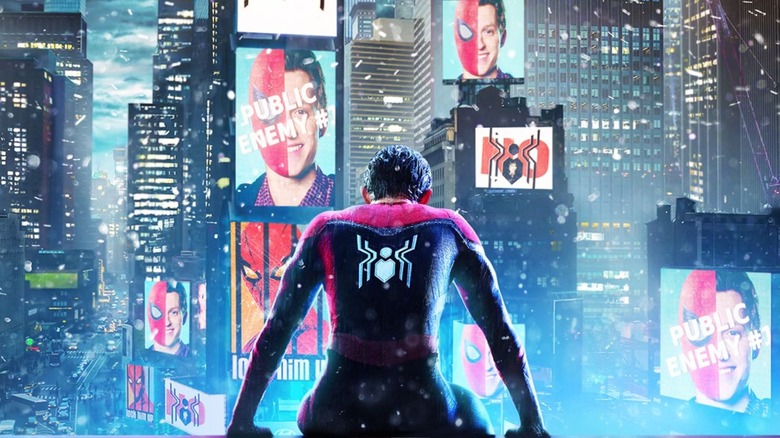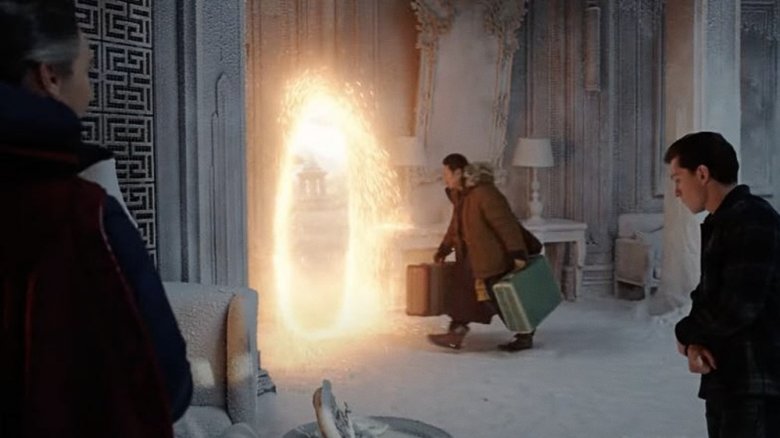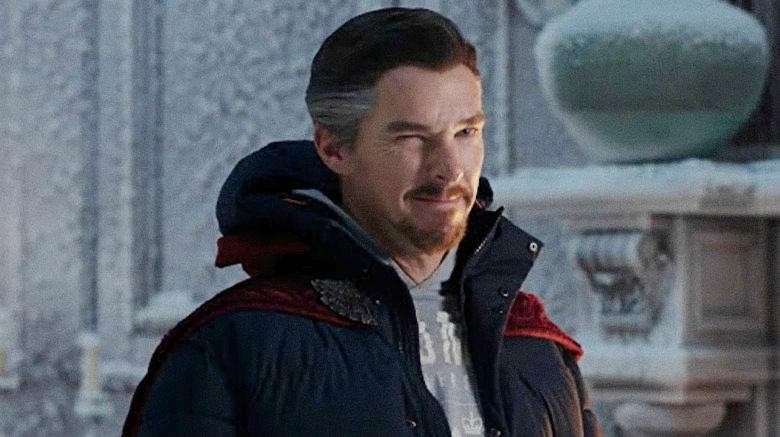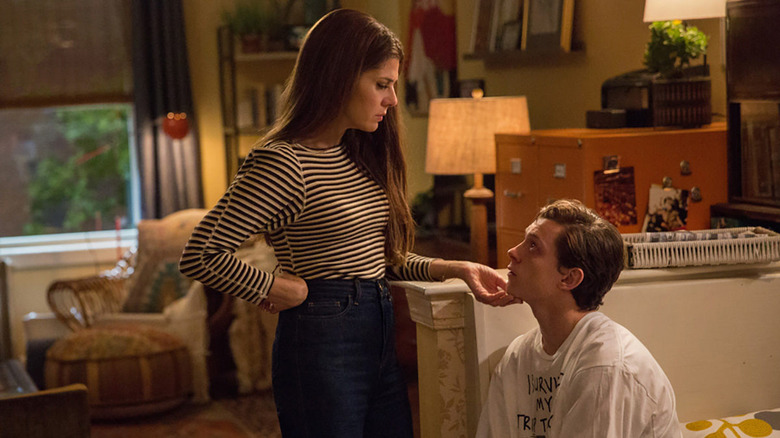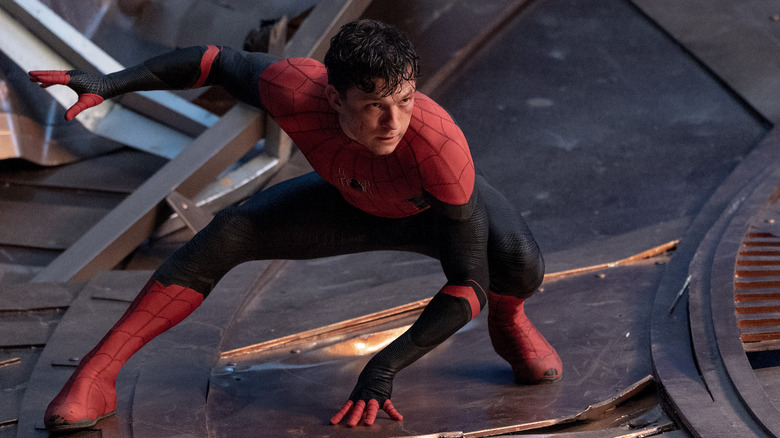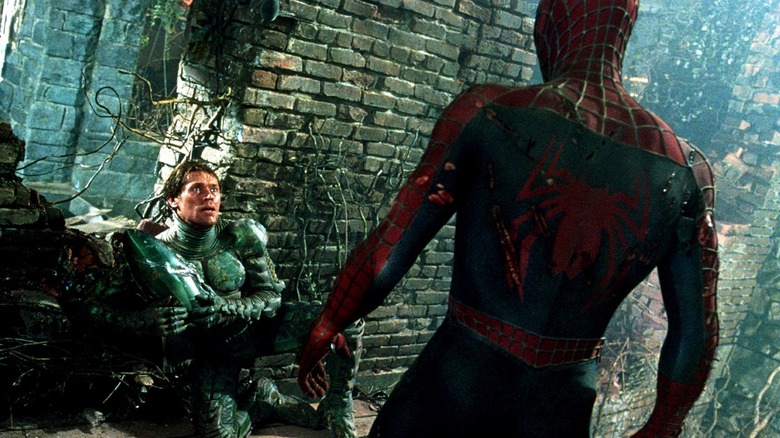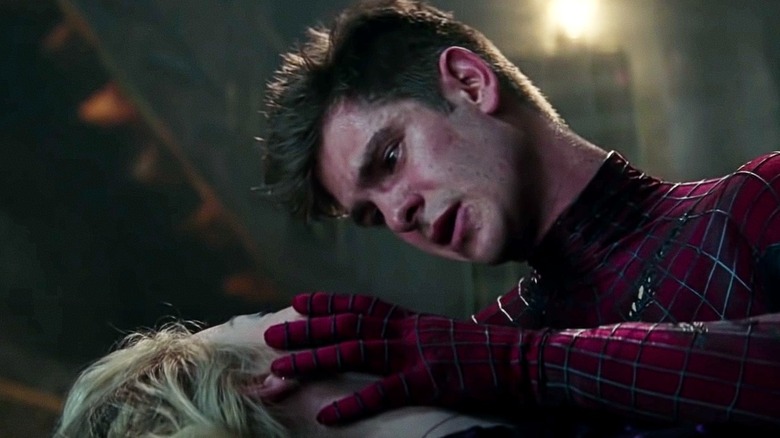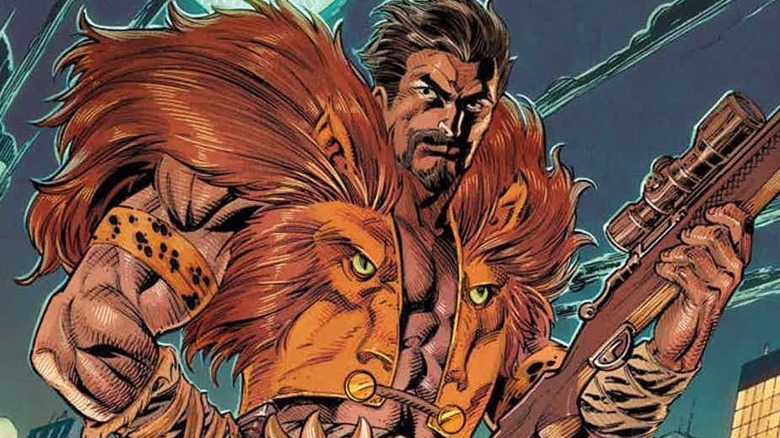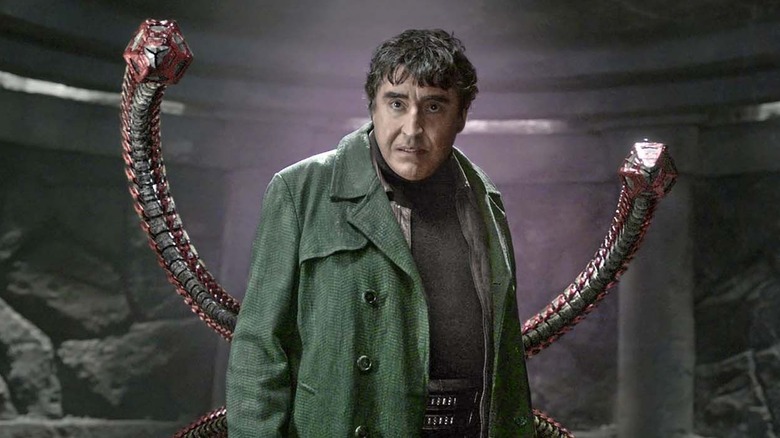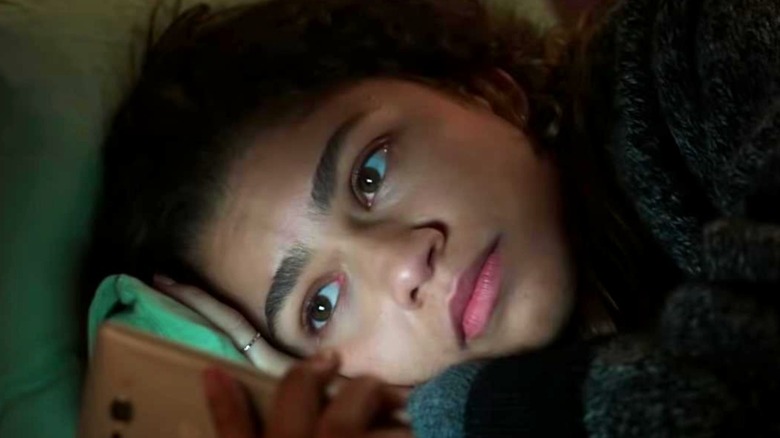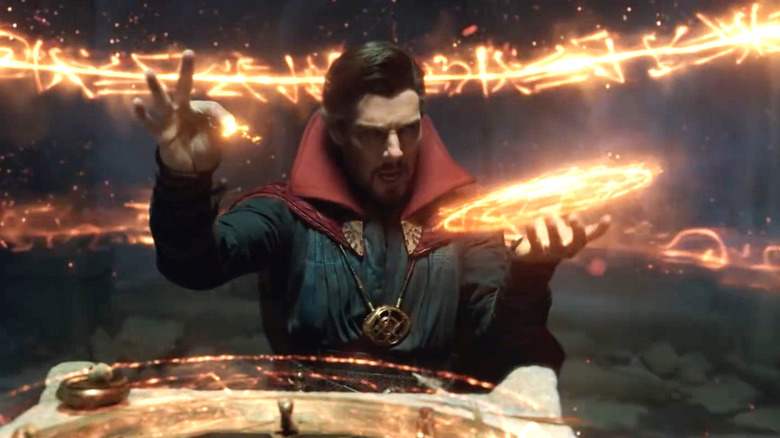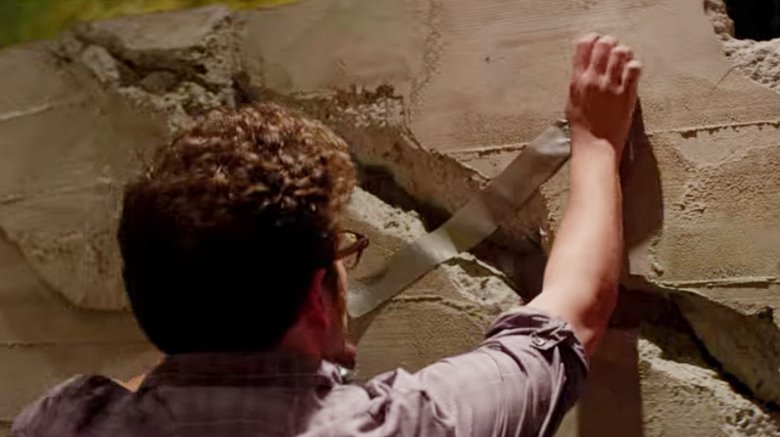Spider-Man: No Way Home Ending Explained: It Takes A Multiverse
It's not easy being Spider-Man. It's even less easy to be Spider-Man when the entire world knows your secret identity and also thinks you're a murderer, thanks to some deathbed slander from Mysterio and a smear campaign by the Daily Bugle. In "Spider-Man: No Way Home," Peter Parker draws the line when his superhero infamy begins to negatively impact his friends' futures, and turns to Doctor Strange to plead for a spell that will make the world forget he's Spider-Man again. As is usually the case with magic, this ends up causing far more problems than it fixes.
Director Jon Watts returns to helm "No Way Home" following the success of "Spider-Man: Homecoming" and "Spider-Man: Far From Home," and a massive amount of credit is due to screenwriters Chris McKenna and Erik Sommers for wrangling the chaotic raw material of the story into a surprisingly coherent script. Against all odds, "No Way Home" taking three different movie franchises and throwing them into a big mixer actually works. And despite all the multiverse shenanigans, the movie's ending manages to wrap things up in a quiet and poignant way.
Needless to say, from here on out there will be major spoilers for "Spider-Man: No Way Home." If you have arrived here by accident and would like to avoid spoilers, kindly follow Sorcerer Supreme Wong through the exit to your left.
Is everyone else still with me?
Okay, let's go!
With Great Power...
Since the fellas in "Spider-Man: No Way Home" came up with a pretty good system for avoiding confusion (even if it took them a couple of tries to get it right), I shall henceforth use their system and refer to the Spider-Men as follows:
- Peter 1 — Marvel Cinematic Universe Spider-Man (Tom Holland)
- Peter 2 — "Spider-Man" Spider-Man (Tobey Maguire)
- Peter 3 — "Amazing Spider-Man" Spider-Man (Andrew Garfield)
Intriguingly, "Spider-Man: No Way Home" reveals that Peters 2 and 3 have something in common that Peter 1 doesn't have: an Uncle Ben. When Peter 1 made his debut in "Captain America: Civil War," he appeared to make an oblique reference to the death of Uncle Ben as he explained his reasons for wanting to be a superhero to Tony Stark:
"When you can do the things that I can, but you don't, and then the bad things happen? They happen because of you."
At the time, this was simply read as a way to fast-forward through Spider-Man's origin story, since the spider bite and the death of Uncle Ben had already gotten the big-screen treatment twice since the turn of the millennium. But "Spider-Man: No Way Home" quietly retcons that hint of a haunted past in order to give Peter 1 his own "death of Uncle Ben" scene after all. Only this time, it's not Uncle Ben who tells Peter that "with great power comes great responsibility." And it's not Uncle Ben who dies and leaves Peter guilt-ridden and rageful.
Sadly, it's time to say goodbye to Marisa Tomei's Aunt May, who gets side-swiped by Green Goblin's glider and then hit while she's down with the blast from one of the Goblin's grenades. There's a "she's okay!" fake-out (a rare cousin to the death fake-out) that lasts just long enough to make you think this movie won't have a major character body count, but then May succumbs to her injuries shortly after delivering the old "great power/great responsibility" chestnut.
The context is not the same; whereas Peters 2 and 3 lost their Uncle Bens as a direct result of letting a thief go free, Peter 1 genuinely was trying to the heroic thing by protecting Green Goblin and the other lost supervillains. Had he simply allowed Doctor Strange to send them back and die, Aunt May would have lived — but at the cost of Peter's principles. It's a tough lesson that sometimes even trying your hardest to do the right thing isn't enough to guarantee a happy ending.
There's a quote often misattributed to the philosopher Edmund Burke: "The only thing necessary for the triumph of evil is for good men to do nothing." It goes hand-in-hand with the idea that with great power comes great responsibility, but while it fits with the death of Uncle Ben in the two previous iterations of Spider-Man's origin story, it doesn't quite tally with the death of Aunt May in "No Way Home." There is an actual Edmund Burke quote, however, that feels a lot more appropriate:
"When bad men combine, the good must associate; else they will fall, one by one, an unpitied sacrifice in a contemptible struggle."
The pain of losing Aunt May is more than Peter can cope with alone. But between MJ and Ned rallying to his side and Spider-Men from other universes commiserating about their own personal tragedies, he's not alone. And that's just as well, because the bad men are combining.
Let's Cure Some Ass!
From his very first appearance in "Captain America: Civil War," Peter 1's arc has been about taking the character from a place where he is safe and supported to a place where he is completely alone, with no one to rely upon but himself. "Spider-Man: Homecoming" laid out the roadmap for the rest of the trilogy when Peter started out with a shiny, high-tech Stark Industries suit, only to have it taken away from him, leaving him to head into the final battle wearing his ropey homemade costume, with no Avengers to back him up.
"Spider-Man: Far From Home" continued to build upon the relationship between Tony Stark and Peter Parker even in the aftermath of Tony's death. Through the execution of his final wishes, we see that Tony, in lieu of being able to put a suit of armor around the world, tried to at least leave his young protégé with his own personal suit of armor. Unfortunately, Tony's background as an arms manufacturer meant that his idea of "armor" was an army of lethal drones. "Far From Home" demonstrated that while Mysterio wasn't the right person to wield that kind of firepower, neither is Peter Parker. Not yet, and maybe not ever.
That brings us to "Spider-Man: No Way Home." It might seem an odd choice, given that Iron Man has been Peter's de facto father figure, to stage the movie's final battle on top of a giant replica of Captain America's shield, rather than a giant arc reactor or at the top of the building formerly known as Stark Tower. After all, aside from some mild bonding over their shared hometown, Peter and Cap never had a chance to get particularly close.
But the fallen shield represents something bigger than Captain America: it represents all the lost leaders and fallen heroes of the MCU. Iron Man is dead, Black Widow is dead, Vision is dead, Captain America is gone, Nick Fury is off in space somewhere doing Top Secret Nick Fury Things, Mysterio turned out to be a fraud, and the remaining Avengers are once again scattered to the four winds. Aunt May was the last domino to fall: the cornerstone of support in Peter's life, who had been there for him long before he ever met Tony Stark or Nick Fury. There's no one left to mentor Peter, or to be his moral guide as he grapples with his powers, or to pull him back when he starts punching a little too hard, and persuade him it's better to cure than to kill.
Well. Almost no one.
Redemption for the Original Spider-Man
"Spider-Man: No Way Home" has a lot of villains in it, but whether by design or by accident, Green Goblin feels like the most full-realized (all credit to Willem Dafoe for coming back after 20 years without missing a single beat). It's easy to forget, after two decades brimming over with superhero movies, just how pivotal Peter Parker's final confrontation with the Green Goblin at the end of Sam Raimi's "Spider-Man" felt. It created a clear roadmap for compelling villains that the very best of the MCU movies made since have followed.
First, and crucially: Norman Osborn wasn't a stranger, but the father of Peter's childhood best friend. With their masks off, the two of them got on very well; Peter saw Dr. Osborn as a role model and mentor, while Norman was impressed by Peter's love of science — to the point that Harry Osborn became jealous that his father liked Peter more than his own son. Throughout the MCU, a similar pattern emerges where the most interesting villains are those whom the hero cannot hurt without hurting themselves, or knowing that they are causing harm to their loved ones: Loki (Thor's adopted brother), Killmonger (Black Panther's cousin), Thanos (Gamora's adoptive father) — and, of course, Adrian Toomes, AKA the Vulture. As "Spider-Man: Homecoming" approached its final act, it greatly complicated things by revealing that the villain was none other than the father of Peter Parker's prom date.
Then there's the tragedy. As entertaining as Dafoe is when he lets his villain grin loose, Norman Osborn is actually a rather tragic character. "No Way Home" draws parallels between him and Doctor Otto Octavius, another scientist whose experiments led to him losing part of his mind and surrendering control to a darker half. In "Spider-Man," the scene where Norman's unravelling mind causes him to behave rudely at a dinner is arguably even more unsettling than scenes where he's whizzing around on a glider in a green costume. And at the end of the movie, Spider-Man still believes that Norman can be saved — right up until the Green Goblin is violently impaled on his own glider in a last-ditch effort to kill Spider-Man.
Apparently not content with wrapping up one "Spider-Man" movie trilogy, "Spider-Man: No Way Home" also takes care to wrap up the unfinished business of the two previous iterations of the franchise. (Come on, that's just showing off.) As the Spider-Men are delegating the development of cures for their various supervillains, Peter 2 quietly reveals that he knows exactly how to cure Green Goblin because he's given it a great deal of thought over the two decades since Norman's death. When Peter 2 intercedes to stop Peter 1 from murdering Norman with the glider, he not only manages to save the very first enemy whom he ever watched die — he also figuratively returns to the night of Uncle Ben's death, and prevents his younger self from giving in to rage and killing for the sake of revenge.
Redemption for the Amazing Spider-Man
One of the most interesting elements of Spider-Man Group Therapy is getting to find out what happened to Peter 2 and Peter 3 in the years since their respective "Spider-Man" movie franchises got the "Etch A Sketch" treatment (shake to erase, and start over). Tobey Maguire's "youth pastor fashion icon" Peter Parker 2 is the more well-adjusted of the two; he's had longer to mature as a person, and he has Mary Jane Watson by his side to keep his life as Peter Parker anchored. Yes, "Spider-Man: No Way Home" confirms that Maguire's Peter and Kirsten Dunst's MJ got their happy ending, even if it did take them a while to get there.
Garfield's Spider-Man didn't get so lucky. Apparently the MJ of the "Amazing Spider-Man" universe never emerged (Shailene Woodley did film scenes as the character for "The Amazing Spider-Man 2," but they were left on the cutting room floor), and despite Peter 3 seeming to shake himself out of his depression at the end of the movie in order to fight Rhino, his grief wasn't magically cured. Whereas Peter 2 managed to find a balance between the two halves of his personality, Garfield's version of the character responds in the negative when asked if he has a significant other, telling Peter 2 that he simply doesn't have time for "Peter Parker stuff."
In truth, he probably could make time for Peter Parker stuff, but chooses not to. Peter 3 confesses to Peter 1 that after Gwen's death he became angry and bitter, and after a while he stopped pulling his punches when beating up the bad guys. He embraced his identity as Spider-Man entirely and left Peter Parker to wither on the vine — fearful of getting close to anyone in case they ended up the same way as Gwen. For Peter 3, meeting Peter 1 allows him to reconnect with his own, younger self. And like Peter 2 and Green Goblin, Peter 3's trip through the multiverse offers him a chance for redemption.
"Spider-Man: No Way Home" comes close to realizing another adaptation of the "Night Gwen Stacy Died" arc from the comics, only this time with MJ falling to her death instead of Gwen. Peter 1 is waylaid by the Green Goblin before he can catch her, but Peter 3 steps in and manages to successfully do what he failed to do years ago in his own universe: save Spider-Man's girlfriend from the jaws of death. It's a powerful moment for Garfield's character, whose eyes are full of tears as he checks to make sure that MJ is OK. When Peter 3 heads back home at the end of the movie, there's a strong sense that his encounter with the other Spider-Men has been healing for him, and perhaps he'll start to make a little more time for "Peter Parker stuff."
The People in the Rifts
Thanks to some accidental intervention from Ned and his borrowed sling ring, Doctor Strange returns from the Mirror Dimension in time for the final battle of "Spider-Man: No Way Home." Unfortunately, before he can press the button on his magic spell box that will put everything back to normal, Green Goblin blows up the box with one of his grenades and unleashes the spell. The sky cracks open as the spell tears rifts in the multiverse, and more people start to come through.
The shapes of the people are hard to make out, but there's a moment where the camera lingers on the emerging shape of a guy with a spear, who could very well be Kraven the Hunter. Aaron Taylor-Johnson is set to play the trophy hunter, who is one of Spider-Man's greatest enemies in the comics, in an upcoming movie, so this could be Sony's way of laying the groundwork for his arrival. The appearance of the rifts in the sky effectively gives both Sony and Marvel Studios a blanket excuse for introducing just about any character into the MCU: "Oh, they came through the multiverse rift and didn't get sent back with everyone else."
The other person in the rift who gets special attention is a broad and hulking shape that could be the Thing, given the upcoming MCU-based "Fantastic Four" reboot, but could also be Paul Giamatti's Rhino from "The Amazing Spider-Man 2." Like Maybe-Kraven, this figure is left just vague enough that it's not certain who it actually is — leaving us to speculate about the possibilities over the next few years.
What Will Happen to the 'Visitors'?
"Spider-Man: No Way Home" wisely doesn't get into the weeds of time manipulation on top of everything else, but it does establish that not all of the multiverse visitors came from the same time in their own universes. Villains like Doc Ock, Green Goblin, and Electro are transported into the MCU from the moment just before they died, whereas Peter 2 and Peter 3 were plucked from their own versions of the present day (which, in the MCU, is 2023). After being reunited with his former enemy, Doc Ock observes that Peter 2 is now "grown up" compared to the last time he saw him.
By curing the supervillains rather than killing them, it's strongly implied that Peter 1 has saved them — and, in so doing, has changed the timelines of their respective universes. It's unclear whether (for example) Peter 2 and the newly cured Norman Osborn will now return to the same universe, or whether Norman being cured will kick off a whole new timeline and give birth to a new universe. "Spider-Man: No Way Home" avoids tangling with this question (again, a wise decision), and instead simply settles for implying that all of the supervillains now have a second chance to be better people.
Peter Who?
Saving the multiverse from total collapse comes at a price. Since the original spell was designed to make the whole world forget that Peter Parker is Spider-Man, the only way to repair the damage from it is to cast a spell that makes the world forget Peter Parker ever existed at all. This time around, Peter can't beg for exceptions for his girlfriend or his best friend, so instead he simply plans to find MJ and Ned in the aftermath and explain everything to them.
Peter falters, however, when he sees MJ and Ned making plans for the next chapter of their lives: studying at MIT. And Peter comes to a full stop when MJ brushes back a strand of hair and reveals the band aid covering the cut over her eye that she got in the final battle. The injury is a reminder to Peter that being Spider-Man's girlfriend puts MJ in harm's way, and he decides he can't bear to see the people he loves put in danger like that again.
With that decision, there's a danger of Peter 1 going down the same path that Peter 3 did: pouring all of his energy into being Spider-Man, and neglecting his life as Peter Parker. But the final (pre-credits) scene of "Spider-Man: No Way Home" has an optimistic tone. As Peter gets settled into his new apartment, he unpacks items of significance: the Lego Emperor Palpatine from the Death Star model that he was working on with Ned (which gets destroyed again in "No Way Home"), and a coffee cup from MJ's workplace that says "we are happy to serve you." Rather than being a painful memory that only he can remember, Peter's connection to MJ and Ned — even from afar — will inspire him to be the best, most friendliest friendly neighborhood Spider-Man he can be.
The Consequences for Doctor Strange
While Doctor Strange's final spell of erasing Peter Parker from the entire world's memories appeared to have fixed the multiverse, it was less of a "fix" and more like, well...
Yes, as the post-credits stinger for "Spider-Man: No Way Home" indicates, the multiverse is still pretty f***ed up. In Doctor Strange's defense, he's not the only person who's been a bit irresponsible with the boundaries of reality this year. Wanda Maximoff is currently trying to lead a new life in isolation after accidentally enslaving the minds of an entire town into her bizarre sitcom reality in "WandaVision." Meanwhile, the events of "Loki" cracked open the "Sacred Timeline" into infinite timelines, and Jonathan Majors' Kang the Conqueror will be making a comeback in "Ant-Man and the Wasp: Quantumania." It's going to take more than superglue and a few throw pillows to fix this mess.
